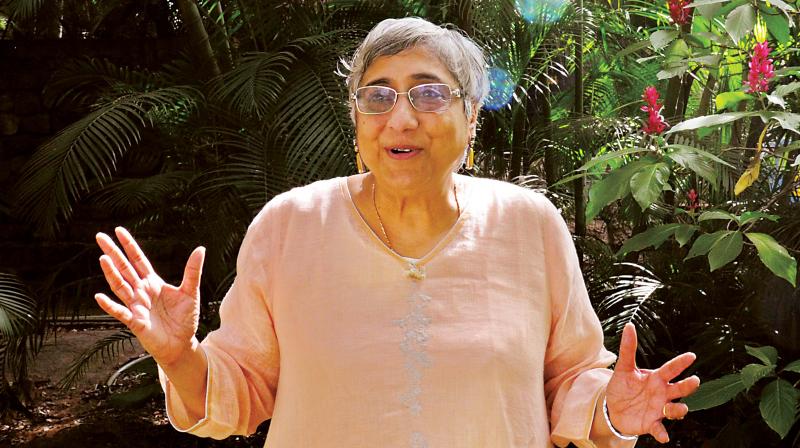Urban Legend: The art guru's designs on tech ed
The digital media revolution has swept everything in its path and mainstream education is no exception to this rule.

The digital media revolution has swept everything in its path and mainstream education is no exception to this rule, even in a placement-oriented country like India. Dr Geetha Narayanan, founder of the Srishti Institute of Art, Design and Technology, who has been at the forefront of the wave, talks to Ralph Alex Arakal about her latest initiatives: bringing new media learning to the urban poor and Lab in a Bag, a progressive, tech-driven approach to teaching science across communities.
Everyone has dreams, but not all manage to achieve them. It is this journey of realisation of her hopes and ambitions that sets Dr Geetha Narayanan apart from the ordinary folks. From teaching maths to merely dreaming of doing something worthwhile in the area of design, she today has the satisfaction of looking back at 20 years as the founding director of the Srishti Institute of Art, Design and Technology in the city.
Arriving in Bengaluru from Madurai with her husband, Ravi Narayan after his transfer to the city several decades ago, she began to teach maths at the American Community School (now Bangalore International School). Interestingly, she found common cause with the school principal, Anne Warrior , and together they founded the famed Mallya Aditi International School with support from the Ujjwal Trust in 1984.
Finally on her way to realising her dreams, she decided to act on her love for design some 12 years later and set up the Srishti Institute of Art, Design and Technology in 1996. Established as a design home for 30 students in four different courses at the time, the institute today has 1,300 students pursuing 53 courses at its different campuses in Bengaluru and Pune.
The years since have seen many accolades come Dr Narayan's way, not least of them global recognition as an “innovative educationist.” Not only is she now a Director’s Fellow at the Media Lab, Massachusetts Institute of Technology, USA, she is also a board member of the International Council of Societies of Industrial Design.
Her achievements have not been without struggle. Dr Narayan recalls that art and design were not considered a good enough professional option in the India of the nineties. “Convincing people to think about art and design as a career option was tedious. As an institute which never had a patron to clear its path to development, finding resources and support for it has always been a challenge,” she says.
The effort has been worth it as Srishti is now the only institution in the country with a UNESCO chair in culture, habitat and sustainable development. “Art is both global and local at the same time and so making it universal, eternal and enduring is what we need to strive for in the future.”
The inspiration for Srishti came from her travels, readings and constant meetings with global educators, she explains. “My goal was to build an institution that allowed the aspirations of artists and of those in the field of culture to grow,” Dr Narayan adds.
A strong believer and promoter of holistic education, she is all for reforms in all spheres of education in the country. “Our policy-makers should realise the importance of providing education at an inter-disciplinary level in a holistic construct. While mass media channels, the Internet and smartphone apps have opened a gateway of information, it’s high time we realised that knowledge in the present era has taken a multi-disciplinary route,” she remarks.
Foreseeing the scope of the industry, Dr Narayan has come up with a unique project which aims to create a learning model for urban poor communities using new media arts and critical pedagogy. Her other initiative, ‘Lab in a Bag’ tries to bridge the most progressive ways of teaching science by using a digital media approach across communities.
As for the future of design and creativity, she has a tremendous vision, seeing the field make over a 40 per cent contribution to the Indian economy quite soon. “Creative professionals will take over spots where imagination plays a role in almost all spheres of life and industry. If India’s boom of the last decade was built on technology, its growth in the next decade will be based on its creativity,” she forecasts.
As someone who fell in love with design and international education at the same time, Dr Narayanan believes that a college-goer should never confine his or her goals to a mere placement. “The three to four years one spends in college are undoubtedly the best time of one’s life. Learning, discovering, and experiencing life while enjoying it is something that can influence us forever and must be cherished. But constant updates in the field of education are essential for a better tomorrow and to tap the best resources. The future should stem from an education that fosters imagination, intellect and intuition,” she adds in summation.
While she has shown tremendous gumption in following her dreams, some may argue that being an educationist and a successful one at that , runs in her blood. After- all Dr Narayan’s grandfather founded the Maharani Lakshmi Ammanni College for Women in Malleswaram in the city several years ago. But what makes her journey commendable is her steady determination to get where she has while remaining true to her ideals all along. It’s a story of a dream well realised.

